Starfield offers a plethora of planets and moons to discover. But what do you do when you’re actually wandering around down there on some rando planet in a distant star system? Outside of questing, Starfield features an incredibly lightweight exploration feature called surveying. This is a great way to go sightseeing, but also profit a little from selling the data you record about each far-flung destination. Maybe you’ll even spot the perfect place to build a future Outpost.
This guide will help you get an idea of what awaits you on a planet’s surface and how to understand Starfield’s different biomes and scannable resources.
Buy Starfield: Amazon | Best Buy | GameStop
Starfield Surveying: Start with the Constellation mission board
If you’re ready to hop into your ship and scan a random planet, don’t let me stop you. But consider that Constellation missions will net you more credits and XP for surveying.
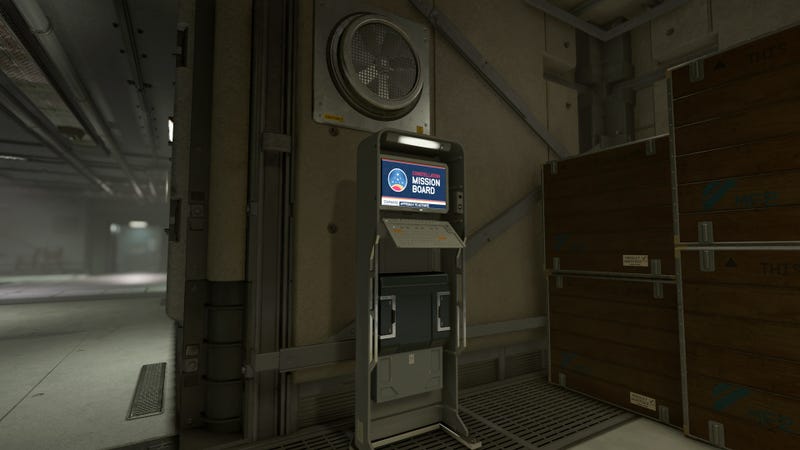
You can get those from the Constellation mission board in the basement of the Lodge on Jemison. Upon entering the Lodge, you’ll see a door on the right under the staircase. It’s locked, but if you progress the Constellation main quest past the initial introduction of meeting the members, you’ll get the key.
Head downstairs through the door and you’ll find some crafting stations and the Constellation mission board. Grab a bunch of missions and then get ready to head out to start doing some science.
Before you land: Scan
Scanning a planet is a good habit to get into even if you’re not dead-set on surveying and exploring just yet. Starfield’s quests take you to a number of different worlds, so you might as well take that brief moment in orbit to scan for resources.
Holding LB (or R on mouse and keyboard) will quickly scan the planet you’re orbiting, showing you varying concentrations of resources across its surface. Knowledge of what materials are where will play an essential role in mining and outpost building, but for now, simply scanning will juice your survey and will let you know if the planet or moon has any Traits you’ll need to find to complete your final report.
Once you have that scan, it’s time to move on to some actual fieldwork.
Starfield: Surveying fundamentals
Nearly every planet and moon you can land on in Starfield has one or all of the following:
- Flora: Plant life
- Fauna: Animal life
- Resources: Minerals and chemicals you can extract
- Traits: Unique geological or biological aspects of the location
You’ll need to scan all of these in order to fully survey a planet, which you can check the progress of in the star map or by opening up your scanner while walking around. You’ll need to scan eight specimens of each plant and animal to check it off your list. Resources like chemicals and elements only need to be scanned once. While you need to get pretty close to scan most objects, the game throws you a bone on flying and swimming creatures, which you can catalog from afar. No need to get that nice spacesuit wet.
Some planets or moons might have little more than a few Resources. Others will have more elaborate features and ecosystems that require you to travel to different regions on the planet, otherwise known as biomes.
How to check planet biomes
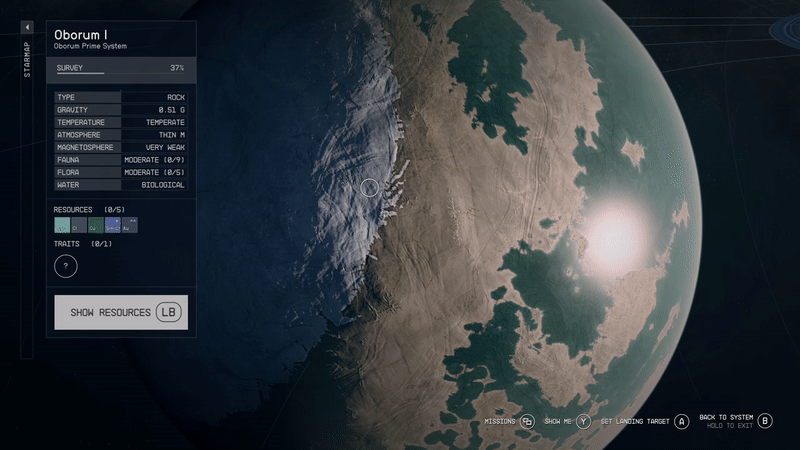
Identifying which specific biome you’re currently standing in isn’t a straightforward process, as you’ll need to check from the star map. Zoom in on the planet and select an area you’d like to land; you’ll see a description of what biome it is and how much of said biome you’ve scanned.
While on foot, you’ll know you’ve scanned every possible flora, fauna, or resource in a given biome when the HUD states “Biome Complete” next to that specific category.
Bigger planets may feature multiple biomes, each of which has unique flora and fauna. Barren worlds with no atmospheres typically only feature one biome, however.
Finding planetary Traits
Finding all of a planet’s Traits isn’t always an easy process. To start, you’ll want to open your scanner and look for icons for icons listed as “Natural,” “Anomaly,” or “Life Signs.” At first, these might appear as an “Unknown” icon or other symbol. Scan it with your scanner and it should reveal its real icon.
These “Natural” points of interest will have various icons, such as a diamond, obelisk, snowflake, or other symbol. Follow these HUD indicators until you arrive at a specific site such as a mass of crystals, remnants of a glacier, or colonies of microbes. Once you arrive, you’ll be asked to scan specific parts of the Trait, after which a badge will appear in the survey HUD showing that you’ve successfully catalogued it.
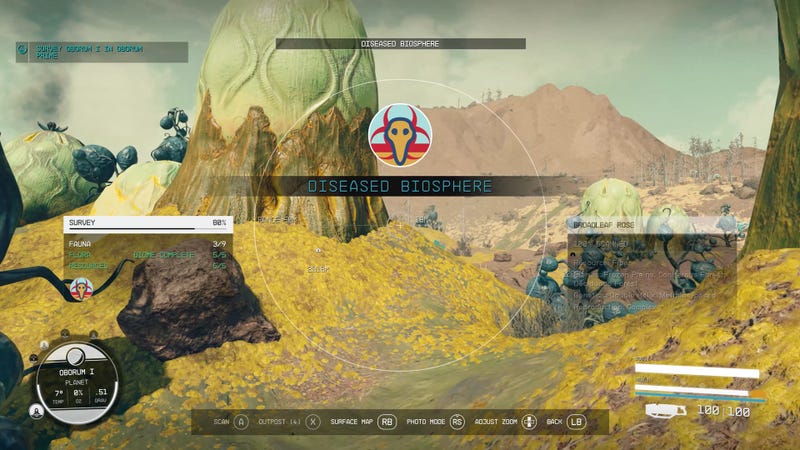
If walking around a specific landing area doesn’t net you all of your Traits, you might have better luck in one of the planet’s other biomes.
Essential surveying skills and tips
Your scanner isn’t terribly effective at the beginning of the game. Placing skill points into Surveying in the Science skills will increase your zoom level and let you scan resources, flora, and fauna from as far as 50 meters away at the highest level. This is a very specific skill to invest your points into, but it will make surveying smoother and faster.
Here are some other skills to consider:
- Boost Pack Training (Tech) speeds up ground traversal
- Astrophysics (Science) lets you get more data from the initial orbital scan
- Fitness (Physical) increase your oxygen so you can sprint for longer
- Xenosociology (Social) can help scare off or disarm hostile alien life
Out of all of these, Boost Pack Training results in the biggest quality of life improvement to Starfield adventuring across the board, so you should be grabbing it anyway.
Surveying strange alien worlds isn’t the safest activity. You’re likely to run into scuffles with hostile alien wildlife, stumble into hostile humans, and suffer injury from toxic environments and falls.
Read More: Starfield: Afflictions and Environmental Damage Explained
Be sure to take a good spread of healing items, including ones that’ll heal status conditions such as burns, hypothermia, and so on.
Don’t forget the fish!
Starfield doesn’t feature much action in the water, but there are fish. If you find yourself wandering a planet endlessly unable to fund the last two or three fauna, simply head to a spot with a sufficient body of water and get your scanner out. You’ll likely find some fish.
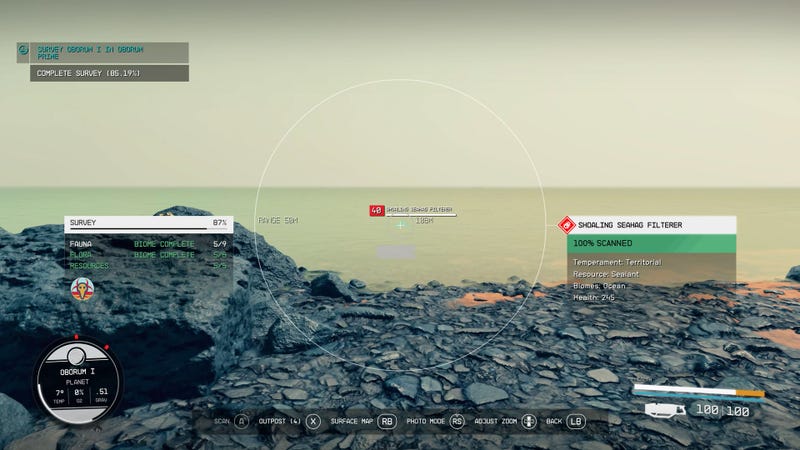
Encountering bodies of water is actually quite rare unless you specifically aim to land on a coastline. From the space map, click around on ocean-adjacent land until you find a biome that has “(Coast)” after its name. Land there, and you’ll be about a minute’s journey from the water.
What to do once you survey a planet
Once you’ve fully surveyed a planet you can move on to survey other remaining planets and moons in the system. Each time you 100% a planet, you’ll get Survey Data added to your notes. You can sell these for credits. It’s not much, but if you spend a decent chunk of time surveying worlds, it will add up (Survey Data value varies from planet to planet).
And while it isn’t mandatory, surveying a planet is a good first step toward building an Outpost. Your first Outpost should ideally be on a planet with access to Iron and Aluminum. Understanding every resource a planet has to offer is essential to planning out what your function your Outpost will handle, be that mining, fabricating, or crafting.
What about structures?
As you explore different worlds, you’ll also take note of various structures. These pre-fab areas are prone to repeating themselves. Some are completely abandoned but contain loot, others are filled with hostile humans or robots, and you’ll also find simple human outposts where you might get a simple quest or two, which can include killing some pirates or providing transport to another world.
None of this stuff affects your surveying, but it can help provide a break if all the science gets a little too monotonous.
Buy Starfield: Amazon | Best Buy | GameStop
Taking the time to soak in the sights of Starfield is one of the best aspects of the game.
Surveying and planetary exploration offer a steady pace of usually uninterrupted, peaceful gameplay focused on vibes and pretty sights. It’s a great way to earn some extra XP and credits, and will give you a nice break from being everyone’s favorite galactic problem solver.
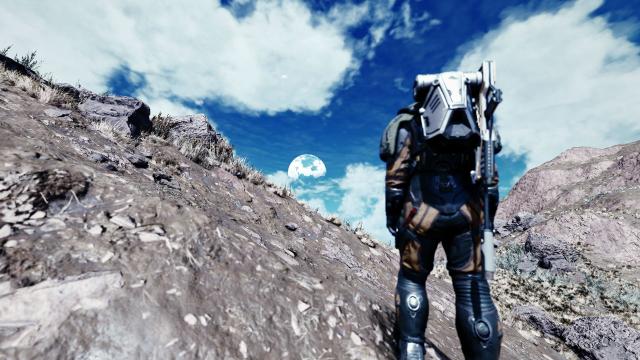
Leave a Reply